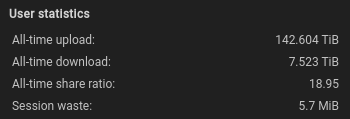

Ooh, neat. There’s also puepy, which was linked further down in this thread. It’s really cool to see more WASM projects pop up.


Ooh, neat. There’s also puepy, which was linked further down in this thread. It’s really cool to see more WASM projects pop up.


Somebody should write a python to javascript transpiler for the web…
(please don’t actually do that)
Duck typing moment


You’re not wrong, but it bugs me when my ratio drops, so I always seed everything I download. I have a pretty good internet service though.
My stats:



deleted by creator


I think odin could be a good fit. I haven’t used it myself. It seems to focus on 3D and game dev.
Maybe it’s still using the borked config because all sessions were not exited? Try exiting it and then make sure no tmux process is still running, by for example running ps -aux | grep tmux.
Otherwise there must be some tmux config still lying around in your $HOME.
Edit: I don’t know anything about Macs so I’m just assuming it works similar to linux.
Does fzf search hidden folders? You could also try with this, to make extra sure: find $HOME -name "*tmux*".
Linux uses 8 spaces. Excerpt from the official style guide:
Tabs are 8 characters, and thus indentations are also 8 characters. There are heretic movements that try to make indentations 4 (or even 2!) characters deep, and that is akin to trying to define the value of PI to be 3.
Rationale: The whole idea behind indentation is to clearly define where a block of control starts and ends. Especially when you’ve been looking at your screen for 20 straight hours, you’ll find it a lot easier to see how the indentation works if you have large indentations.
Now, some people will claim that having 8-character indentations makes the code move too far to the right, and makes it hard to read on a 80-character terminal screen. The answer to that is that if you need more than 3 levels of indentation, you’re screwed anyway, and should fix your program.
In short, 8-char indents make things easier to read, and have the added benefit of warning you when you’re nesting your functions too deep. Heed that warning.
The reasoning seems sound, but I still prefer 4 personally.
I used vscode for a few years, but I eventually went back to neovim/tmux. It’s a lot less resource heavy, and it’s easy to just ssh and jump in from home. I also much prefer a modal editor and I don’t want to have to touch a mouse.


What makes Servo a better bet than Ladybird? Who backs it?


Since people keep bringing up tauri, here’s the comparison made in the README:
Tauri is a framework for building desktop (and soon, mobile) apps where your frontend is written in a web-based framework like React, Vue, Svelte, etc. Whenever you need to do native work, you can write Rust functions and call them from your frontend.
Natively Rust: Tauri’s architecture limits your UI to either JavaScript or WebAssembly. With Dioxus, your Rust code is running natively on the user’s machine, letting you do things like spawning threads, accessing the filesystem, without any IPC bridge. This drastically simplifies your app’s architecture and makes it easier to build. You can build a Tauri app with Dioxus-Web as a frontend if you’d like.
Different scopes: Tauri needs to support JavaScript and its complex build tooling, limiting the scope of what you can do with it. Since Dioxus is exclusively focused on Rust, we’re able to provide extra utilities like Server Functions, advanced bundling, and a native renderer.
Shared DNA: While Tauri and Dioxus are separate projects, they do share libraries like Tao and Wry: windowing and webview libraries maintained by the Tauri team.


That’s OK, we all got our own preferences 😉 But I think you will be pretty good to go on t495. It has apparently been linux certified on older Ubuntu, which Mint is based on.
https://ubuntu.com/certified/201905-27049
Also linux certified by Lenovo:
https://support.lenovo.com/us/en/solutions/pd500343-linux-certification-thinkpad-t495-20njz4krus


For arch you can look here:


deleted by creator
deleted by creator


nam is assigned the value returned by input.
This is not some edge case behavior by the input function. This is always how function calls work. You can think of it like substituting input('Who are you? ') with the value returned by it, which is the string typed in by the user in this case.


Drop oh-my-zsh and look for something else to customize your prompt. I like Powerlevel10k but Starship is good too.


C is a pretty simple language and relatively easy to learn. But it’s a lot harder to be proficient with.
Codeberg looks pretty good at a quick glance.